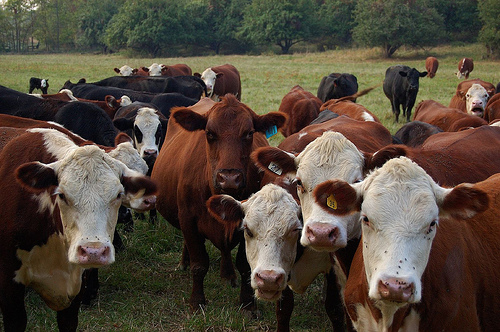
Agricultural News
Can We Rebuild the Cow Herd? Part 2
Mon, 03 Dec 2012 13:10:16 CST

In the second of a three-part series published in the latest Cow-Calf Newsletter, Derrell S. Peel, Oklahoma State University Extension Livestock Marketing Specialist, continues his discussion on the challenges to rebuilding the nation's cow herd.
A dramatic jump in demand for corn, which began in late 2006, has resulted in sharply higher prices for all crops in the U.S. A simple average across the eight major cultivated crops shows that 2012 crop year prices are expected to be 165 percent higher than in 2005. This has provoked intense competition among crops for land resources with crop market prices doing short term battle each year for acreage to plant. The epicenter of this crop frenzy is naturally in the Midwest and is reflected in the phenomenal jump in land values and rental rates in the region.
Longer term impacts on land use are also expected as a result of this new agricultural environment. Though data is limited, there are strong indications that these long term changes have begun and they have significant implications for the beef cattle industry. The 2007 Natural Resources Inventory (NRI) showed that in addition to 305 million acres of cultivated cropland, an additional 119 million acres are used for pasture along with 52 million acres of non-cultivated cropland (mostly permanent hay). These 171 million acres of pasture and "hay" land are arable, meaning they can be farmed. A majority of these acres occur in and around the major cropping areas and generally in the eastern half of the country. These acres do not include another 400 million acres of rangeland (plus forest and federal lands) that are not arable. Rangeland is mostly located in the drier central and western regions of the U.S.
Though converting perennial pasture and hay crops to cultivated crops is not an easy or quick process, high crop prices will logically attract some of these acres for cultivated crop production over time. At this point there is little data to confirm how much pasture and hay land is being converted to crop production. The 2012 NRI and Agricultural Census data (which will be available in several months) are expected to provide the first documentation of a process that is likely to continue for many more years.
In the absence of land use data, changes in cattle inventories across states already indicates some of the anticipated regional impacts of high crop values. From January 1, 2007 to 2012, the U.S. beef cow herd decreased by 2.76 million head or 8.5 percent. The decrease is much more pronounced in the Midwest and surrounding regions, including the states of Illinois, Indiana, Iowa, Minnesota, Missouri, Kentucky and Tennessee. In these states, the five year decrease in beef cow inventory ranged from 11.4 percent to over 22 percent with an average of a 14.2 percent decrease. By contrast 12 states in the Great Plains and Rocky Mountain regions experienced beef cow herd changes that ranged from an increase of five-plus percent to a 7.5 percent decrease with an average of 2.6 percent decrease across the region. Texas and Oklahoma experienced sharp decreases from 2011 to 2012 due to drought but had a similar 3.1 percent decrease in the 2007-2011 period. This indicates that the beef cow herd is decreasing more rapidly in regions where competition with crops is greater. As a result, an increasing share of the total beef cow herd will be located in drier regions of the country in the future. Interestingly, this same phenomenon is occurring in other major beef producing countries such as Brazil, Argentina, Uruguay and Paraguay and for the same reasons.
Depending on their location, it is not surprising that some cattle producers see less potential for herd rebuilding than others. Beef cow herds are less likely to rebuild in major crop production regions while predominantly forage areas have considerable potential for herd expansion. There is little doubt that some of the most productive pasture and hay land is being converted for crop production which highlights the challenge of rebuilding the beef cow herd in more marginal areas. However, high crop prices increase forage value as well and that changes the incentives for how land is used and managed. Forage production, even on rangeland that does not compete directly with crop production, is worth more now. Many years of cheap grain kept forage values low and the result is that forage production and use has not been managed as efficiently as it can be.
Increased forage value opens up a wide variety of possibilities, in many regions, to manage forage for greater productivity and to manage forage use more efficiently. The dramatic increase in use of corn crop residue the last two years is one example of the response to these incentives. Two other examples include reducing hay wastage from round bales and, in Oklahoma and similar areas, more Red Cedar control to increase forage production. In many regions of the country there is considerable potential for adoption of new forages and new forage systems to increase cattle production and/or extend grazing seasons.
This continuing discussion of the challenges and opportunities for rebuilding the U.S. cattle herd will continue in Part 3 with a discussion of who will rebuild the cow herd.
WebReadyTM Powered by WireReady® NSI
Top Agricultural News
More Headlines...



















